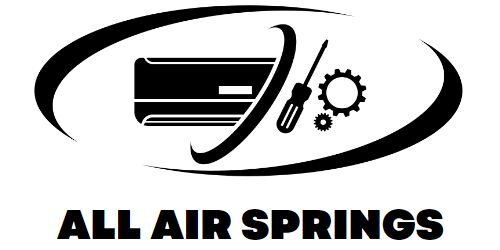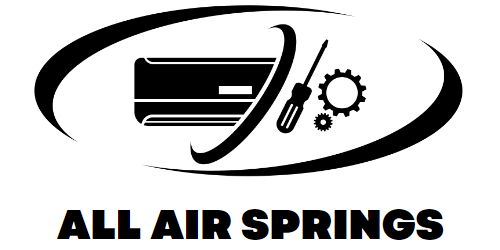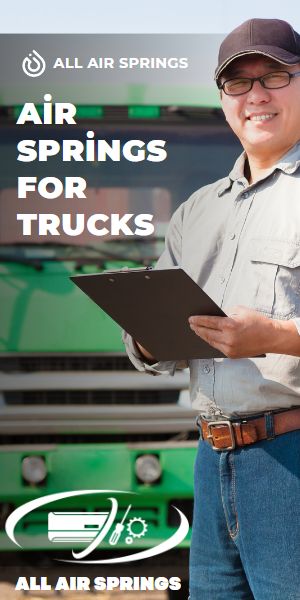
What Are Air Bags for Trucks?
Air bags for trucks are an essential component of modern suspension systems, designed to enhance both the comfort and performance of your vehicle. They function by using air-filled bags, which can be inflated or deflated to adjust the suspension. This helps to absorb shocks, level the load, and provide a smoother ride, especially when hauling heavy cargo.
Truck air bags are typically made from durable rubber or polyurethane, and they come in various sizes to fit different types of trucks. These air bags can be installed in place of traditional coil or leaf springs, or in addition to them for added support. They are primarily used to level the load by adjusting the truck’s height, ensuring that the suspension system remains balanced and the truck stays stable, even under heavy load conditions.
The core benefit of air bags is their ability to provide load leveling, reducing the risk of sagging or bottoming out. By controlling the air pressure inside the bags, truck owners can achieve optimal performance, whether they are towing, carrying a load, or driving on rough terrain. Whether for personal or commercial use, air bags for trucks are a vital upgrade that can significantly improve ride quality, handling, and overall vehicle longevity.
Benefits of Air Bags for Trucks
Air bags for trucks offer a range of benefits that can significantly improve your driving experience, safety, and the longevity of your truck. Here are the key advantages:
-
Enhanced Ride Comfort
: Air bags provide a smoother ride by absorbing shocks and vibrations from the road. This is especially beneficial when driving on rough or uneven surfaces, as they help maintain stability and prevent your truck from bouncing or swaying.
-
Improved Load Handling: One of the primary benefits of air bags is their ability to handle heavy loads efficiently. By adjusting the air pressure within the bags, you can level the truck, preventing sagging under the weight of the load. This results in better towing and load-carrying capacity.
-
Increased Safety: Air bags contribute to safer driving by maintaining proper suspension performance. A well-balanced truck is less likely to lose control, even when carrying a heavy load or towing. This stability helps prevent accidents and ensures a smoother, more secure ride.
-
Extended Suspension Life: Since air bags reduce the strain on the truck’s suspension system, they help extend the lifespan of other suspension components like shocks, struts, and springs. This leads to fewer repairs and overall maintenance savings.
-
Better Handling: Whether you’re driving with a heavy load or going off-road, air bags improve the overall handling and responsiveness of your truck. By providing a customizable ride, air bags ensure your truck performs optimally under various driving conditions.
Overall, investing in air bags for your truck can dramatically improve comfort, safety, and the vehicle’s ability to handle tough tasks.
Types of Air Bags for Trucks
When it comes to choosing the right air bags for your truck, it’s essential to understand the different types available. Each type offers unique features designed to cater to specific needs, ensuring optimal performance for various truck types and driving conditions. Here are the most common types of air bags for trucks:
1. Single Air Bags
Single air bags are typically used in lighter-duty trucks or smaller vehicles. These air bags feature a single chamber that inflates to support the truck’s suspension system. They are ideal for improving ride quality and handling, especially when hauling moderate loads. Single air bags are simple to install and maintain, making them a popular choice for everyday truck use.
2. Double or Dual Air Bags
Dual air bags consist of two separate chambers, one on each side of the axle. This type offers greater load capacity and more precise control over the truck’s suspension. Dual air bags are commonly used in heavier-duty trucks or vehicles that regularly carry or tow heavy loads. They help evenly distribute weight and improve stability, providing a more balanced ride when the truck is under load.
3. Helper Air Bags
Helper air bags are designed to assist the existing suspension system in supporting additional weight. They are often used in combination with leaf springs or coil springs, providing extra support when towing or carrying heavy loads. These air bags help prevent sagging and improve handling without replacing the truck’s primary suspension components.
4. Leveling Air Bags
Leveling air bags are designed to maintain the truck’s ride height by automatically adjusting the air pressure in response to the load. These are often found in larger commercial trucks or towing vehicles, where maintaining an even suspension is essential for stability and safety.
5. Air Bag Kits
For those looking to install air bags on their truck as an upgrade, air bag kits are available. These kits come with everything needed to install a complete air suspension system, including air bags, compressors, air lines, and mounting hardware. Air bag kits are ideal for truck owners who want full control over their vehicle’s suspension and handling.
Understanding the different types of air bags helps you make an informed decision when selecting the best option for your truck’s needs, ensuring enhanced performance and safety.
How to Choose the Best Air Bags for Your Truck
Choosing the best air bags for your truck is essential for enhancing its performance, handling, and safety. With various options available on the market, it’s important to consider several factors before making your purchase. Here are key points to guide you in selecting the right air bags for your truck:
1. Load Capacity
The load capacity of the air bags is one of the most important factors to consider. Air bags are designed to handle different weight ranges, so you should choose air bags that can support the weight of your truck when it’s fully loaded. Be sure to check the manufacturer’s specifications and select air bags that match your towing or carrying needs.
2. Truck Type and Use
Different trucks may require different air bag types. For example, a light-duty truck used for daily commuting may only need single air bags, while a heavy-duty truck used for towing or carrying large loads may require dual or helper air bags. Assess how you use your truck (towing, off-roading, heavy hauling) to determine which air bags will best meet your needs.
3. Compatibility
It’s crucial to choose air bags that are compatible with your truck’s suspension system. Some air bags are designed to work specifically with certain suspension setups, such as coil springs, leaf springs, or factory suspension systems. Double-check the compatibility of the air bags with your vehicle’s specifications before purchasing.
4. Adjustability
Air bags with adjustable air pressure are ideal for those who need to modify their truck’s suspension based on the load. Adjustable air bags allow you to fine-tune the suspension for better performance, comfort, and handling, whether you’re hauling light or heavy loads. Look for air bags with an easy-to-use inflation system for convenience.
5. Material and Durability
The durability of air bags largely depends on the material used in their construction. High-quality air bags are typically made from heavy-duty rubber or polyurethane, designed to withstand the harsh conditions of frequent use. Consider the material of the air bags and ensure they are built to last, especially if you plan to use your truck for demanding tasks.
6. Installation and Maintenance
Consider how easy it will be to install and maintain the air bags. Some air bags are easier to install than others, and many come with detailed instructions. If you’re not comfortable with DIY installations, look for air bags that can be professionally installed. Additionally, check for ease of maintenance, such as air pressure adjustments and leak detection.
By considering these factors, you can select air bags that offer optimal performance, durability, and convenience for your truck’s needs. Properly chosen air bags can provide a smoother ride, improved handling, and increased safety for your vehicle.
Installation Process for Air Bags in Trucks
Installing air bags in your truck can significantly enhance its performance, but it’s important to follow the correct installation steps to ensure proper functioning. Whether you choose to install them yourself or hire a professional, here’s an overview of the typical installation process for air bags in trucks:
1. Preparation
Before starting the installation, make sure you have all the necessary tools and parts. Most air bag kits come with detailed instructions, air bags, compressors (if needed), air lines, and mounting brackets. It’s crucial to have a clean and safe work area with enough space to lift your truck if necessary. Additionally, check your truck’s manual to ensure compatibility with the chosen air bags.
2. Lift the Truck
For safety and ease of installation, use a hydraulic jack or a lift to raise your truck. Make sure to place jack stands under the truck to ensure stability while working underneath it. Depending on the type of air bags you’re installing, you may need to lift the truck enough to access the suspension components where the air bags will be mounted.
3. Remove Existing Suspension Components (If Necessary)
If you’re replacing existing suspension components, such as coil springs or leaf springs, they will need to be removed. Carefully follow the manufacturer’s instructions for detaching these components. Be sure to keep track of any bolts, nuts, or hardware you remove, as you’ll need some of them for the new air bag installation.
4. Install the Air Bags
Position the air bags according to the instructions provided in the kit. The bags will typically be placed either between the axle and frame or in place of the existing suspension components. Secure the air bags using the provided mounting brackets, ensuring they are aligned properly and securely attached. Double-check all connections to make sure they are tight and stable.
5. Install the Air Lines and Compressor
If your air bags require an air compressor system, install the air lines and compressor as outlined in the instructions. The compressor should be mounted in a secure, accessible location, and the air lines should be routed to each air bag. Be careful not to kink the air lines and ensure they are properly secured to avoid damage or leaks.
6. Check for Leaks and Test the System
Once the air bags are installed, check for any air leaks by inflating the bags. Use soapy water to spray around the connections and air lines, looking for any bubbles that indicate leaks. If everything checks out, test the system by adjusting the air pressure and ensuring the truck’s suspension is leveled properly. Make sure the truck handles as expected, and all components function smoothly.
7. Lower the Truck and Final Inspection
After ensuring that the air bags and components are securely in place and functioning correctly, carefully lower your truck back to the ground. Perform a final inspection to check for any loose bolts, misaligned parts, or signs of wear. Make sure everything is tightened and secure before driving.
While the installation of air bags can be done by experienced DIYers, it’s recommended to seek professional help if you’re not familiar with suspension systems. Professional installation ensures that the air bags are correctly mounted, providing safe and effective performance.
By following these steps carefully, you can ensure that your air bag system is properly installed, providing long-term benefits for your truck’s performance and ride quality.
Maintenance and Care for Truck Air Bags
Proper maintenance and care for your truck’s air bags are essential for ensuring their longevity, safety, and performance. Air bags, like any other component of your vehicle, require regular attention to keep them functioning optimally. Here are key maintenance tips to help you take care of your air bags:
1. Regular Inspections
Perform regular visual inspections of your air bags to check for any signs of damage, wear, or leakage. Look for cracks, cuts, or bulging, which could indicate the need for replacement. Inspect the air lines and fittings for signs of wear, such as abrasions or leaks. Any visible damage should be addressed immediately to prevent more serious issues.
2. Check Air Pressure
Maintaining the correct air pressure inside the air bags is crucial for optimal performance. Too little air pressure can result in a rough ride and poor load support, while excessive pressure can lead to over-stretching the bags and potential damage. Regularly check the air pressure using a reliable gauge and adjust it according to the weight load you’re carrying. Make sure to follow the manufacturer’s guidelines for proper pressure levels.
3. Monitor for Leaks
Air leaks are one of the most common issues with air bags. Leaks can cause a loss of air pressure, leading to a decrease in ride quality and suspension performance. To detect leaks, you can apply soapy water to the connections and air lines. If bubbles form, you have a leak that needs to be addressed. Tighten connections and replace any faulty components, such as valves, seals, or air lines.
4. Keep the Air Bags Clean
Dirt and debris can build up on the air bags over time, potentially causing wear or damage to the material. Clean the air bags regularly with a mild detergent and water to remove dirt and grime. Avoid using harsh chemicals or abrasives that could damage the rubber or polyurethane material. Also, ensure that the air lines and fittings are kept free of dirt to maintain proper air flow.
5. Inspect the Compressor System
If your air bags are connected to an air compressor system, ensure that the compressor is in good working condition. Check for signs of wear or corrosion on the compressor unit and its components. The air compressor should be able to cycle on and off properly and maintain consistent pressure levels. Regularly inspect the compressor for oil or moisture buildup and address any issues promptly.
6. Address Performance Issues Promptly
If you notice any changes in the way your truck handles or rides—such as sagging, roughness, or an unbalanced load—it’s important to address these issues right away. These problems may indicate an issue with your air bags, such as a leak or incorrect pressure. Timely repairs or adjustments can prevent further damage and ensure your air bags continue to perform effectively.
7. Professional Maintenance
While basic inspections and maintenance can be done by truck owners, it’s a good idea to have your air bags professionally inspected periodically, especially if you use your truck for heavy-duty tasks. A professional mechanic can thoroughly check for hidden issues, ensure that the air bags are working optimally, and replace any worn-out parts.
By following these maintenance tips, you can extend the life of your truck’s air bags and ensure that your vehicle continues to perform safely and smoothly. Regular care will also help prevent costly repairs and ensure that your truck is ready to handle heavy loads or rough conditions with ease.
Common Issues with Air Bags and How to Fix Them
While air bags are a reliable and durable solution for improving your truck’s suspension, they can experience issues over time. Recognizing and addressing common problems promptly can prevent further damage and ensure your truck’s performance is not compromised. Here are some of the most common issues with truck air bags and tips on how to fix them:
1. Air Leaks
One of the most frequent problems with air bags is air leaks, which can cause the bags to lose pressure and reduce their effectiveness. Leaks can occur at the air lines, valves, or connections.
Solution:
- Check for leaks by applying soapy water to the fittings and air lines. If bubbles form, you have a leak.
- Tighten any loose connections or replace worn-out seals and air lines. If the leak is significant, it might be necessary to replace the damaged air bag.
- Inspect the air bag itself for cracks or punctures that could also cause leaks.
2. Sagging Suspension
If the air bags aren’t holding the proper air pressure or if there’s a leak, the truck’s suspension may sag, especially when carrying heavy loads. This leads to reduced load support and a rough ride.
Solution:
- Check the air pressure and adjust it to the recommended level.
- Inspect the air bags for damage or leaks that could be causing them to deflate.
- Replace any damaged air bags and ensure the air compressor system is functioning correctly.
3. Uneven Ride Height
If your truck is sitting unevenly or tilted to one side, it could be due to an imbalance in the air bags or issues with the air pressure distribution.
Solution:
- Verify that the air bags are evenly inflated on both sides of the truck. Uneven pressure can lead to an unbalanced suspension.
- Check for any leaks or blockages in the air lines that could prevent the bags from inflating properly.
- If the air bags are damaged, replacing them with new ones should correct the issue.
4. Compressor Problems
The air compressor is responsible for inflating the air bags, and if it fails, the air bags won’t be able to function properly. Common compressor issues include failure to activate, inability to maintain pressure, or excessive noise during operation.
Solution:
- Inspect the compressor for any visible damage, such as loose connections or corrosion.
- If the compressor is not working, check the fuse, wiring, and electrical connections to ensure everything is intact.
- If the compressor is old or damaged beyond repair, replace it with a new one.
5. Air Bag Wear and Tear
Over time, the air bags can experience wear and tear, especially if the truck is subjected to heavy use, rough roads, or extreme weather conditions. This can lead to cracks, holes, or weakened material, reducing their efficiency.
Solution:
- Inspect the air bags regularly for any signs of damage, such as visible cracks or abrasions.
- Clean the air bags with a mild detergent to remove dirt and debris that could cause deterioration.
- If the air bags show significant wear or damage, replace them with new ones to restore the truck’s suspension performance.
6. Faulty Pressure Sensors
Some air bag systems come with pressure sensors that monitor and adjust air pressure automatically. If the pressure sensors malfunction, the air bags may not inflate to the correct pressure, leading to poor performance.
Solution:
- Inspect the pressure sensors for any wiring issues or damage.
- Test the sensors to ensure they are reading and adjusting pressure accurately.
- Replace faulty sensors to restore the system’s ability to maintain proper air pressure.
7. Incorrect Installation
In some cases, air bags may not perform as expected due to incorrect installation. Misaligned air bags, improper air line routing, or incorrectly mounted components can all lead to issues such as leaks, poor ride quality, and suspension problems.
Solution:
- Double-check the installation according to the manufacturer’s guidelines. Ensure that all components are mounted securely and aligned correctly.
- If you suspect the air bags were installed improperly, consult a professional mechanic to inspect and correct the installation.
8. Clogged Air Lines
Clogs in the air lines can prevent the air from flowing properly to the air bags, affecting their inflation and performance.
Solution:
- Inspect the air lines for any signs of blockages or obstructions.
- If necessary, clean the air lines or replace any damaged sections to restore the flow of air to the air bags.
By addressing these common issues quickly and effectively, you can ensure that your truck’s air bag system continues to function properly. Regular maintenance, timely repairs, and early detection of problems will help you avoid more serious damage and keep your truck performing at its best.
For detailed information, you can contact us at torqueusa.com


